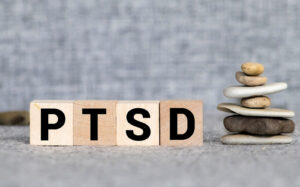Post-Traumatic Stress Disorder (PTSD) is a condition that can deeply impact one’s life. It often brings overwhelming experiences to the surface. To be triggered means encountering a situation, sound, smell, or image that recalls the trauma. Therefore, leading to intense emotional and physical reactions. Understanding these triggers and their effects is crucial to managing PTSD.
However, when triggered, it can be challenging to know what to do next. When you’re experiencing a PTSD trigger, your nervous system is so dysregulated that and can make it feel impossible to cope. It’s essential to have a plan in place for when these moments occur.
Understanding Your Triggers

What are Common Types of Triggers?
PTSD triggers can manifest in various forms, touching different aspects of our sensory and emotional experiences. Your triggers can vary from someone else’s, and it’s essential to recognize your personal triggers. Some common types of PTSD triggers include:
- Sights: Visual reminders, such as seeing a person, place, or object similar to something involved in the traumatic event.
- Sounds: Specific noises or tones, like loud bangs or sirens, can recall traumatic moments.
- Smells: Odors that were present during the traumatic event can instantly evoke distressing memories.
- Emotions: Feeling a certain way, such as fear or anger, can trigger memories associated with the trauma.
- Situations: Engaging in activities or being in environments that resemble aspects of the traumatic event.
When your mind and body are triggered, your sympathetic nervous system kicks in with the fight, flight, or freeze response. This can make you feel overwhelmed and out of control. So, how do you figure out what to do when it feels like your body and mind are hijacked? How do you know what will help you feel safe and regulated in these moments?
Examples of Triggers That Might Affect People with PTSD
Maybe you struggle with knowing when you’re triggered. Understanding what situations, emotions, or sensations trigger you is the first step in managing them. Some examples of triggers that might affect people with PTSD include:
- Anniversaries: Dates related to the traumatic event can bring up intense emotions and memories.
- Crowds or Social Interactions: Being around large groups of people or engaging in social interactions can be triggering for some individuals.
- Conflict: People who have experienced trauma may feel triggered by conflict or arguments.
- Loss of Control: Feeling out of control or powerless in a situation can be a significant trigger for those with PTSD.
- Natural Disasters: Those who have experienced a traumatic event related to a natural disaster may be triggered by storms, earthquakes, or other similar occurrences.
Triggers can be unpredictable and may vary from person to person. It’s essential to take note of what triggers you specifically and how it affects your mind and body. Over time, you may be able to identify patterns and develop coping strategies.
Immediate Coping Strategies
When you’ve just been triggered, it’s essential to have some quick strategies you can use to help regulate your nervous system. These techniques should be simple, easy to remember, and something that works for you. Some immediate coping strategies for when you’re triggered may include:
Grounding Techniques

- Deep Breathing: Take deep, slow breaths to help regulate your nervous system and calm your mind.
- 5-4-3-2-1 Technique: Notice five things you see, four things you feel, three things you hear, two things you smell, and one thing you taste.
- Progressive Muscle Relaxation: Tense and relax each muscle group in your body to release tension and stress.
Mindfulness Practices
Mindfulness practices can support you in staying present and focused, even when triggers threaten to pull you away. By bringing your attention back to the here and now and acknowledging thoughts and feelings without judgment, you can maintain a sense of presence. Breathing exercises, such as focusing on the rise and fall of your chest, can help center your thoughts. Additionally, mindful observation, which involves closely observing an object’s shape, color, and texture, allows you to immerse yourself entirely in the task.
Safe Place Visualization
For those dealing with PTSD, having a specific safe spot to visualize can be a solid coping mechanism when triggers hit. This exercise involves picturing a calm and secure place where you feel at ease. It might be a real place from your past or a completely imagined one. Make the visualization vivid by incorporating details like the scent of flowers or the sound of waves. When you’re feeling overwhelmed, take a moment to close your eyes and immerse yourself in this safe spot.
Regulating Your Emotions
Recognizing and naming your emotions is crucial for emotional regulation. By pinpointing what you’re feeling, you can more effectively tackle the source of your stress or discomfort. Take a moment to pause and assess your emotional state. Are you anxious, angry, sad, or something else? Sometimes, writing down your feelings can help clarify things. This process isn’t about judging your emotions but acknowledging them.
Recognizing your emotions is essential. It lets you deal with them head-on instead of letting them take charge. Ignoring or suppressing feelings usually backfires, making things worse. By acknowledging your emotions, you gain better insight into your reactions and can treat yourself more fairly. It’s normal to feel what you feel, and giving yourself the room to experience these emotions can help stabilize your emotional well-being. Some ways to regulate your emotions may include:
- Mindfulness Practice: Spend a few minutes each day simply observing your thoughts and feelings without judgment.
- Emotion Wheel: Use an emotion wheel, a tool that categorizes emotions, to help pinpoint exactly what you’re feeling.
- Body Scan: Take a moment to scan your body from head to toe, noting any physical sensations. Often, emotions manifest physically, and recognizing this can help you identify your emotions.
Self-Soothing Techniques
When emotions are running wild, it’s important to have strategies to calm down. Self-soothing techniques are personal practices that help you feel better and dial down the intensity. It can be as simple as your favorite playlist, a warm bath, or some gentle yoga. The key is to do what makes you feel safe and relaxed. When you’re feeling overwhelmed, try these practical tips to calm yourself.
Jamming to your favorite tunes can be incredibly soothing, so why not curate a playlist of your go-to chill tracks? A warm bath is another fantastic option; the heat works wonders on easing muscle tension and helping you relax both body and mind. Don’t underestimate the power of deep breathing exercises—try inhaling deeply and exhaling slowly to calm your heart rate and nervous system. And hey, dive into hobbies you love, whether it’s sketching your next masterpiece, getting your hands dirty in the garden, or losing yourself in a gripping novel. These activities aren’t just distractions; they make you feel accomplished and at ease.
Creating a Personalized Self-Soothing Toolkit
A personalized self-soothing toolkit can be a lifesaver when you need instant comfort. Think about filling it with items and activities that genuinely relax and ground you. Maybe it’s that super-soft blanket you love, a few lavender-scented candles, your trusty journal, or that dog-eared favorite book. The goal is to have a go-to collection of things that bring you real peace and security, ready to dive into whenever you need a little extra support.
Seeking Help for PTSD

For instance, a Fort Worth trauma therapist may recommend cognitive-behavioral therapy (CBT), which focuses on identifying and changing unhelpful thought patterns that can contribute to PTSD symptoms. Eye Movement Desensitization and Reprocessing (EMDR) is another type of therapy that has been found to be effective in treating PTSD by helping individuals process traumatic memories.
No matter what trauma treatment in Fort Worth you choose, remember that healing from PTSD takes time and effort. Be kind and patient with yourself as you work towards managing your symptoms and finding peace within yourself. You don’t have to go through this alone, and seeking help is a brave step towards recovery.
Understand Your PTSD Triggers with Expert Trauma Treatment in Fort Worth, Texas
If you or a loved one is struggling with PTSD, know that there is hope and help available. With professional Trauma treatment in Fort Worth, TX, you can learn to understand your triggers, regulate your emotions, and find peace within yourself. At Anew Counseling DFW, we specialize in trauma therapy and provide a safe, compassionate space for you to heal. Our specialized trauma therapists in Fort Worth are here to support you on your journey toward healing and recovery. Take the first step today:
- Fill out our intake form and schedule your free 15-minute consultation.
- Schedule your first appointment to address your childhood trauma.
- Identify triggers, regulate emotions, and find peace with our expert trauma therapists!
Other Therapy Services Offered at Our Fort Worth Therapy Practice
Your triggers and trauma are unique to you, and so should your treatment. Our Fort Worth trauma therapists offer individualized therapy services to meet your specific needs and goals. At Anew Counseling DFW, we offer a variety of therapy services at our Fort Worth, TX-based practice, including Sex Addiction Recovery, and Porn Addiction Treatment. As well as Anxiety Therapy, Depression Therapy, and Couples Therapy. Our team of experienced therapists is dedicated to helping you track your triggers, understand your trauma, and find healing.

Recent Comments